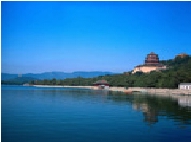|
 Located 15km from Beijing, the Summer
Palace is the largest and best-preserved
royal garden in China. Located 15km from Beijing, the Summer
Palace is the largest and best-preserved
royal garden in China.
The Summer Palace has a history of over
800 years. Early in the Jin dynasty, an
imperial palace named Golden Hill Palace
was built on the present site of the
Summer Palace. In 1750,with 4.48 million
taels of silver, Emperor Qian Long of
the Qing dynasty built the Garden of
Clear Ripples here and renamed the hill
Longevity Hill to celebrate his motherís
birthday.
In 1860, the Anglo-French Allied Forces
invaded Beijing and set fire to the
garden. In 1888, Empress Dowager Cixi,
with funds embezzled from the Imperial
Navy, restored the grand garden. The
construction had lasted for ten year and
after completion, she renamed it
Yiheyuan - Garden of Peace and Harmony.
In 1900, the garden was plundered again
by the eight powers. This time, nearly
all big temples and halls at the back of
the Longevity Hill were destroyed and
only one survived. Only when the
fugitive Cixi returned to Beijing in
1903, did the full-scale restoration
begin.
Mainly consists of Longevity Hill (which
can be divided into Front Hill and Rear
Hill) and Kunming Lake, this present
Summer Palace covers a vast area of 294
hectares, in which three quarters are
water. The garden can be divided into
three parts, namely, administration,
residence and scenery browsing area. The
administration area, taking Halls of
Benevolence and Longevity as its
principal part, is the place where Cixi
dealt with state affairs and received
officials. Residence area mainly
consists of Hall of Jade Billows, Garden
of Virtue and Harmony, and Hall of
Joyful Longevity. The Kunming Lake and
Longevity Hill then serve as the scenery
browsing area.
The Summer Palace has two entrances, one
is the East Palace Gate and the other is
North Palace Gate. Most visitors enter
the garden from the East Palace Gate.
All the man-made hills, halls, pavilions
and temples, including Kunming Lake and
Longevity Hill, blend together
harmoniously in spite of their
individual styles. Ingeniously conceived
and elaborately designed, this garden,
concentrating the features of the
gardens in southern and northern China,
can be reputed as the soul of the
Chinese gardens.
The Summer Palace of today is more or
less the same as the palace rebuilt in
1903. After the last Qing Emperor Puyi
was thrown out of the Summer Palace in
1924, this garden was turned into a
park. But at first, due to the admission
charge was very high, the normal people
still had no chance to view the
magnificent royal garden. Today, most
people can afford the ticket. This old
imperial garden now becomes an ideal
place for Beijing locals to retreat from
the hot summer in Beijing.
Eastern Palace Gate
It is the main entrance to the Summer
Palace. The opening in the center was
for the emperor and empress exclusively.
The two side openings were for the use
of princes and court officials. Eunuchs
and soldiers used side gates to the
south and north. The name plaque "Yiheyuan"
in front of the gate was written by
Emperor Guang Xu. The stone slab in
front of the gate bears a carving in
relief of two dragons playing with a
pearl, a symbol of imperial authority.
Grand Opera Tower
The imperial theater in the Dehe Garden
is the largest of its kind in China
today. It is 21 meters high and has
three floors. An opening is in the
ceiling of the first floor, in which a
winch could lower performers and props
down onto the first floor. Performers
could appear on the three floors at the
same time.
Long Corridor
The 728-meter-long corridor runs from a
moon gate in the east to Shizhang
Pavilion in the west. All the 273
sections are painted with pictures
either of ancient stories or landscapes.
It is the longest and most famous
corridor in China.
Qingyanfang
Also known as Stone Boat, it was made
with huge stone blocks in 1755. The
36-meter-long immovable boat has two
tiers. It was placed in lake to
symbolize the steadfast rule of the Qing
Dynasty.
Bronze Bull
Cast in 1755 the bull has upturned horns
and ears. Its eyes look intensively
ahead. A note of 80 characters inscribed
on its body tells that it was used to
suppress flood.
17- Arch Bridge
The 150-meter-long stone bridge links
the South Islet with the eastern shore
of Kunming Lake. On the heads of
balusters of the bridge there are 544
stone lions of various postures and
looks. |



